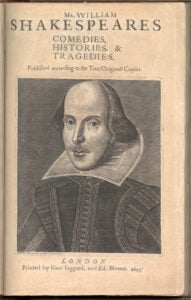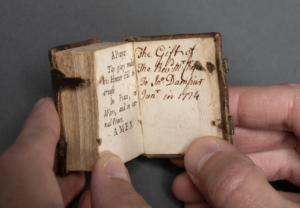AUSTIN, Texas — To mark The 400th anniversary of William Shakespeare’s First Folio, the Harry Ransom Center at The University of Texas at Austin will display all three copies in the library’s collection beginning Aug. 19 as part of the exhibition, Very Old Books Live Long Lives.

The exhibition explores the stories behind the books that were published in Europe between the mid-15th century and the late-17th century. It traces them from the printing houses to generations of bookbinders, collectors, and finally, modern research libraries like the Ransom Center.
“Analyzing books as historical artifacts allows us to move beyond content to discover how they were originally made, who owned them, the transformations they’ve undergone, and how they’ve been read, used, abused and altered over the centuries,” said Aaron T. Pratt, the Carl and Lily Pforzheimer Curator of Early Books and Manuscripts, who organized the exhibition.
Visitors will encounter a number of exceptional volumes, including a “Don Quixote” that has been annotated by a class-conscious reader, a Bible that purportedly traveled to New England on the Mayflower, an atlas owned by Oliver Cromwell, a group of playbooks implicated in a series of high-profile thefts, and more. Around 1970, a Harvard University student used a 16th-century text as his personal journal. Early books are often used in surprising and unexpected ways.
“Every early book in the Ransom Center’s collection has a unique story to tell,” said Claire M. L. Bourne, Associate Professor of English at the Pennsylvania State University and former Ransom Center research fellow. “Unlike institutions that have selected books based on their pristine condition, the Center boasts a large number of ‘dirty’ books, ones that carry the weight — and intrigue — of their histories with them.”

Scholars estimate between 750 to 1,200 copies were published at the time. Of them, 228 can currently be traced — and three of the four copies preserved in Texas are in the Ransom Center’s collection. Published posthumously in 1623, the large-format volume features 36 of Shakespeare’s plays, half of which had not been printed previously.
The Harry Ransom Center is home to extensive collections of early books and manuscripts, including cuneiform tablets, ancient papyri, 10th-century Quran fragments, a complete copy of the Gutenberg Bible, manuscripts and early printed editions of Geoffrey Chaucer’s “The Canterbury Tales,” quartos and folios by Shakespeare, landmarks in the history of science, and much more.
“Surviving books offer us glimpses into the lives of people who have come before us. They offer evidence that can help us develop new narratives about the past and better understand our own values today,” Pratt said.
Its collections include the papers of modern and contemporary writers such as J. M. Coetzee, Don DeLillo, Gabriel García Márquez, James Joyce, Jack Kerouac, D. H. Lawrence, Doris Lessing, Norman Mailer, Carson McCullers, Anne Sexton, David Foster Wallace and many others, and it is a destination for rare book and manuscript research.
The Center’s copy of the Gutenberg Bible, printed in the 1450s by Johann Gutenberg and his partner Johann Fust, is always on view. It represents one of only 20 complete copies in the world that survive intact, and the printing process pioneered by Gutenberg’s team transformed how information traveled in Europe and, later, the world.
Very Old Books Live a Long Life You can find more information online at hrc.utexas.edu. For more information, visit hrc.utexas.edu.




